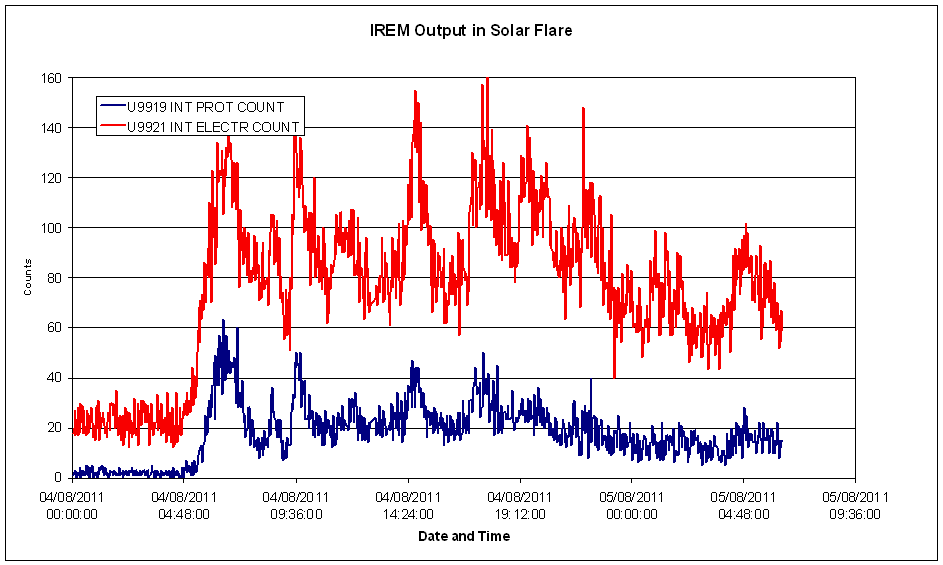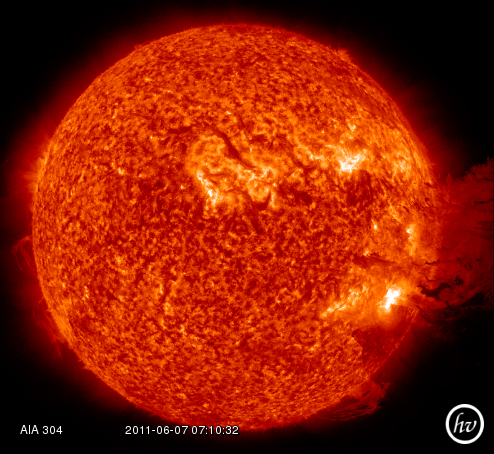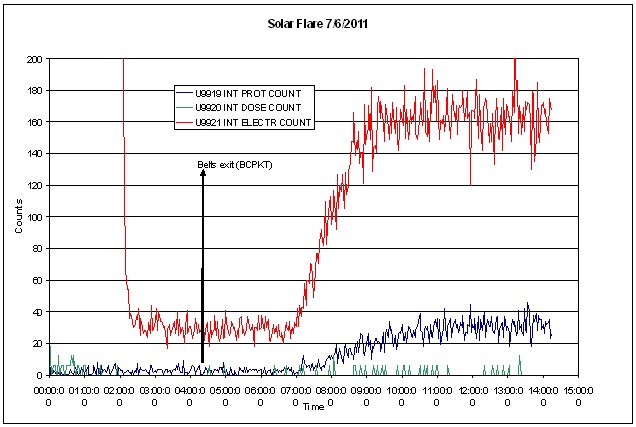INTEGRAL News Archive for 2011 - INTEGRAL
INTEGRAL News archive for 2011
AO-9 Data Right Proposals approved
16 December 2011 The ESA Director of Science and Robotic Exploration, Prof. Alvaro Giménez, has approved the recommendation of the Time Allocation Committee (TAC) for proposals to obtain data rights for targets within approved AO-9 observations. The proposers have been informed about the TAC decision and about the detailed data rights obtained. An overview of successful AO-9 data rights proposals can be found here.

AO-9 Data Right Proposals - results
31 October 2011 During the call for Data Right Proposals (deadline 17 October 2011) the ISOC system received 52 valid proposals, requesting data rights to 155 fields and for 477 targets in total (a single data right proposal can request observational data from multiple fields defined in observing proposals and multiple sources in each field). As expected, the large majority of requests was for Compact Objects. The Time Allocation Committee will decide on the proposals by mid November 2011.
| Category | Number of proposals | Number of subscriptions | Number of sources requested | % (# of proposals) |
| Galactic Astronomy | 39 | 122 | 355 | 75.0 |
| Extragalactic Astronomy | 12 | 23 | 60 | 23.1 |
| Nucleosynthesis and diffuse continuum/line emission |
1 | 10 | 62 | 1.9 |
| Total | 52 | 155 | 477 | 100 |

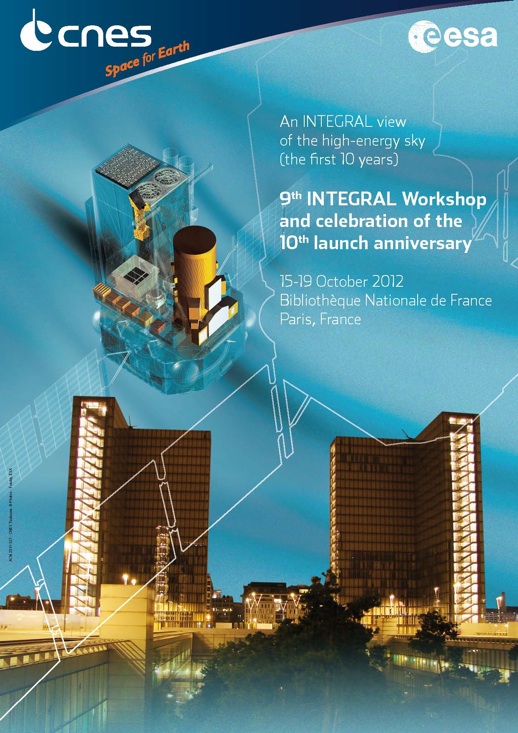
An INTEGRAL view of the high-energy sky (the first 10 years)
25 October 2011 The 9th INTEGRAL workshop "An INTEGRAL view of the high-energy sky (the first 10 years)" will take place from 15-19 October 2012 in Paris, Bibliothèque Nationale de France (Bibliothèque François Mitterrand).
The main goal of this workshop is to present and to discuss latest results obtained in the field of high-energy astrophysics using INTEGRAL, as well as results from observations from other ground- and space-based high-energy observatories and from associated multi-wavelength campaigns.
For more information see the workshop web page.

Closer than ever in the last nine years
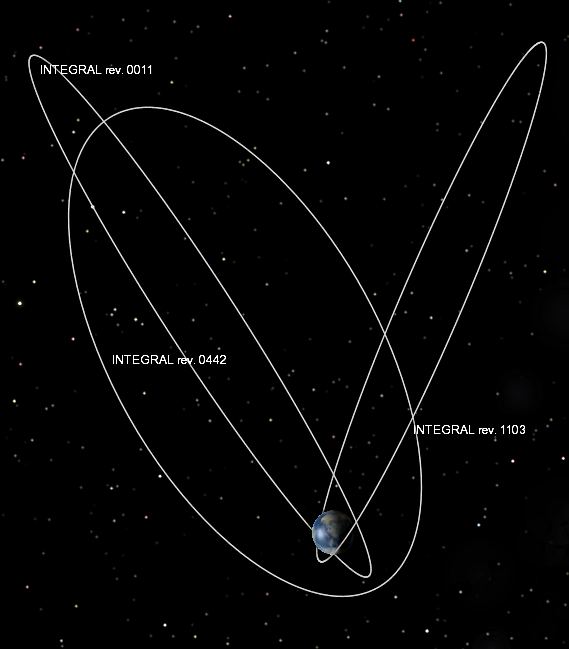
The increased particle radiation as INTEGRAL is passing through the proton belts is noted in accelerated degradation of the solar arrays. Still, the power margin is very good and appears sufficient to comfortably operate the satellite without additional power constraints until the end of the current mission extension. No significant effects of the increased radiation on the instruments have been observed.
The image to the right visualizes the shape of three selected INTEGRAL revolutions for the early mission, peak perigee height and the perigee minimum. Note that the elliptical shapes seem elongated also due to projection effects as the plane of the orbit has rotated over the years. Click on the image to see a larger version. A movie created using Celestia to demonstrate the whole evolution can be found here (OGG format, 7.6 Mb).

Extension of deadline for INTEGRAL AO-9 Data Right Proposals
14 October 2011 Due to a software bug, the Proposal Query Tool for AO-9 Data Rights returned erroneously zero exposure for specific source positions in well-exposed fields. The error has been corrected this morning, but in order to allow all proposers to submit proposals based on correct information, the Project Scientist has decided to extend the proposal deadline to Monday, 17 October 2011, 14:00 CEST (Madrid local time). For any further questions please contact the INTEGRAL Helpdesk at inthelp@sciops.esa.int, which will be manned over the weekend.

Supernova SN 2011fe in M101
3 October 2011 After the initial observations of the type Ia nearby supernova SN 2011fe in M101 (ATel #3581) during early September (see INTEGRAL news 29 August 2011 ), INTEGRAL will continue observations of this exceptional Target of Opportunity with two sets of observations, which together will span the time interval from day 45 until day 88 after explosion, or, from 7 October until about 19 November.
A 2 Ms observation will begin on 7 October, aiming at the detection of high energy emission from 56Co decay gamma-ray lines and its associated Compton-scattered continuum. All data from this 2 Ms observation will be made publicly available immediately. These ToO observations target the rise of such emission towards the maximum, which is expected to show characteristic differences for different progenitor and explosion models. Observations are in standard 5x5 dither mode for broader usage of these public data.
These public observations will be complemented by a proprietary 1 Ms ToO observation as approved for AO-8 (PI: J. Isern), which will be scheduled to cover the expected gamma-ray maximum emission from the 56 Co lines, starting at day 74 after explosion, or 5 November.
For more information on upcoming observations please consult the Schedule Information page.
Christoph Winkler
INTEGRAL Project Scientist
3 October 2011

Explore the high-energy Universe competition
26 September 2011 ESA invites secondary school students to participate in a challenging competition to explore the high-energy Universe.
Students at secondary school are invited to choose from four projects relating to ESA's INTEGRAL gamma-ray observatory in which they are challenged to Observe, Research, Design or Build. A number of great prizes are on offer, the top prize for the overall winners of each project is a trip to Paris, France, to attend and present their work at the 9th INTEGRAL science workshop. The competition will run until 31 March 2012.
More details can be found here http://sci.esa.int/INTEGRAL-competition

INTEGRAL AO-9 Call for Data Right Proposals is open!
5 September 2011 Today, the Director of Science and Robotic Exploration (Prof. Alvaro Giménez-Cañete) has released the 9th Announcement of Opportunity for data right proposals with INTEGRAL.
This announcement solicits proposals for obtaining data rights to targets within AO-9 observations to be carried out from January 2012 onwards. Proposers from all over the world are welcome to participate. All proposals will be subject to an independent peer review by the INTEGRAL Time Allocation Committee (TAC). The deadline for Proposals submission is Friday 14 October 2011, 14:00 CEST (12:00 GMT).
More information can be found on the AO-9 Data Right Proposals page.

INTEGRAL follows nearby supernova
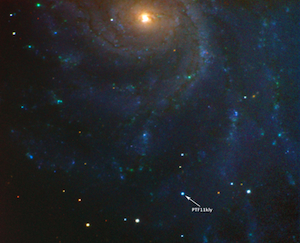

Back to normal operations
06 August 2011 The radiation environment has returned to normal levels and nominal instrument operations have been resumed after the perigee / eclipse passage from revolution 1075 to 1076.

Active Sun affects INTEGRAL again
05 August 2011 A solar flare (class M9.3) on 04 August 2011 with associated bright coronal mass ejection has led to IBIS, JEM-X and OMC being in safe mode for the second time this year after a similar event in June. High background radiation levels due to the solar flare are persisting at the moment. Nominal operations will be resumed once the particle background level has subsided again. See also the spaceweather news.

INTEGRAL AO-9 General Programme approved
08 July 2011 The INTEGRAL AO-9 General Programme , as recommended by the Time Allocation Committee (TAC) and approved on the 5th of July by the ESA Director of Science and Robotic Exploration (Prof. Alvaro Giménez), has been released and the observers have been informed.

Major infrastructure upgrade at ESAC
06 July 2011 Due to a major upgrade of the ESAC computing infrastructure, the Integral Web pages and e-mail services will be unavailable from Friday, July 8th, 17.00 until Saturday, July 9th, 17.00. We are sorry for any inconvenience this may cause.

ToO observation on 4U 0115+63
22 June 2011 INTEGRAL began a series of Target of Opportunity exposures on the Be-/X-ray binary 4U 0115+63, which was caught in a new outburst by MAXI (ATel #3430) and INTEGRAL (ATel #3434). More exposures are being considered and the observing strategy depends on the flux evolution.Please consult the scheduling pages for more information.

Back to normal operations
9 June 2011 Further receding background levels have permitted to reactivate also the INTEGRAL monitors JEM-X and OMC in the night from 8 to 9 June. All instruments are now back in normal science operations.

Instruments recover slowly
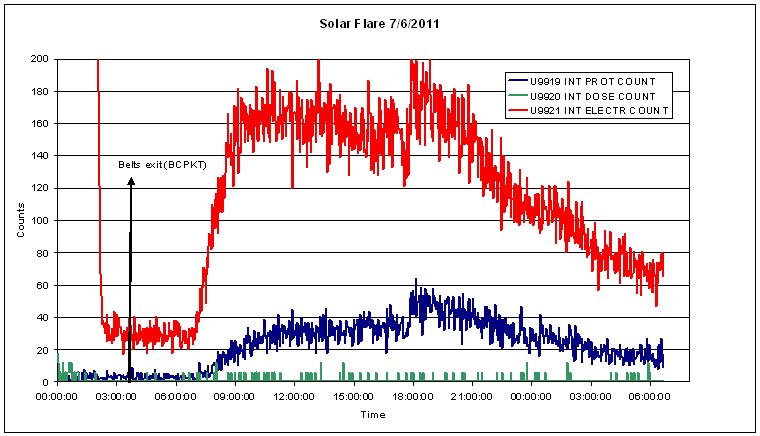

Solar flare shuts down instruments
7 June 2011 For the first time since end 2006 a solar flare has led to INTEGRAL instruments being shut off for high energy particle radiation. Around 06:41 an eruption created an M2-class flare and a massive CME (see spaceweather site for more details). The INTEGRAL particle radiation counters indicated quickly rising rates from about 07:08 onwards. At 07:28 IBIS went to safe mode, followed by OMC at 07:42 and JEM-X at 08:18. SPI continued to operate. Star tracker and AOCS operations are proceeding normally. Nominal operations will be resumed once the particle background level has subsided again. The image of the Sun below was obtained from Helioviewer.

INTEGRAL Galactic Plane Scans
Keeping watch over our Galaxy, the return of the GPS!
11 May 2011 For the first 5 years of INTEGRALs operational life, the scientific Core Programme included a key component that was the regular scanning of the Galactic Plane. This led to a wealth of discoveries of new sources and source types, a large fraction of which were highly transient. These discoveries can certainly be considered one of the strongest results from, and legacies of, INTEGRAL.
Since AO-5, these regular scans have been discontinued, and this has resulted in a significant drop in the discovery rate of new systems in and around the plane of our Galaxy. The new Galactic Plane Scans (PI: Angela Bazzano), approved as a Key Programme throughout AO-8 and possibly AO-9, will allow the regular monitoring of known systems, and dramatically enhance the chances of discovering new ones. Such a programme will be of high value to a very large fraction of the high energy astronomical community, stimulating science immediately, and furthermore contributing greatly to the INTEGRAL legacy.
More specifically, continued observations along the Galactic Plane will provide a more uniform and longer baseline monitoring of the sources already discovered (variability and recurrence being key diagnostic parameters) and high probability of new source detection - such studies do not reach the point of 'diminishing returns' in the same way that persistent source searches in high exposure regions do. Transient object studies are still crucial since they the are the only source for which large luminosity variations allow us to rapidly sample a variety of physical conditions.
Any interesting source behavior that emerges from the proposed observations will be announced promptly, so that rapid follow-up by the community will be possible in short time.
All data from the GPS observations will be made publicly available.
The forthcoming GPS observations in AO-8 are scheduled as follows:
| Start (UTC) | End (UTC) | Rev |
| 14 May 05:21 | 15 May 07:51 | 1048 |
| 16 May 08:28 | 16 May 21:13 | 1048 |
| 17 May 05:11 | 17 May 18:56 | 1049 |
| 18 May 19:51 | 19 May 20:20 | 1049 |
For more schedule details and future GPS observations, please consult the INTEGRAL scheduling information.

9th Announcement of Opportunity (AO-9): preliminary statistics
20 April 2011 The deadline for the submission of proposals for AO-9 open time observations was on 15 April 2011, and all proposals are in the ISOC database. Below are some preliminary statistics on the proposals that have been received.
Total number of proposals
The total number of proposals received is 49. The total observing time requested is about 70 Msec (for all types of observation, i.e. fixed time, normal time, and ToO). Here, 10% of the requested total ToO time has been taken into account. Given that up to about 24 Msec of observing time will be available for the AO-9 observing programme (12 months duration starting on 01 January 2012), this corresponds to an oversubscription in time by a factor of 2.9. This is again a high value, showing the continued high interest of the scientific community in the INTEGRAL mission.
Proposals per category
In the following table we give the breakdown of number of proposals as a function of the proposal category. Note that the numbers on requested observing times do include ToO proposals, but it has been assumed here, that a typical ToO proposal requests about 10% of its total observing time as entered into PGT from all the candidate sources included in a ToO proposal.
| Scientific Category | Number of proposals | Requested observing time (Ms), includes ToO times x 10% |
| Galactic Astronomy | 31 | 34.3 |
| Extragalactic Astronomy | 10 | 19.0 |
| Nucleosynthesis and diffuse continnum/line emission |
8 | 17.1 |
| Total | 49 | 70.4 |
The Time Allocation Committee, will peer review early June all proposals and recommend a scientific observing programme to ESA. Following this meeting, ESA will announce the approved observing program for the AO-9 cycle of observations.
A second Call within this AO-9 will be released on 5 September, inviting proposals on individual point sources or selected sky areas (for diffuse emission studies) to be associated as "data-right proposals" with the selected observations, excluding ToO observations. The deadline for submission of data rights proposal will be 14 October 2011.
Christoph Winkler
INTEGRAL Project Scientist
20 April 2011

INTEGRAL observes a possible new HMXB in outburst
2 April 2011 RXTE observations of the Small Magellanic Cloud have revealed a possible new High-Mass X-ray Binary in outburst. INTEGRAL observations, starting at the beginning of revolution 1034, will permit the uncertainty in the location of this source to be greatly reduced, permitting follow-up observations at other wavelengths.

INTEGRAL observes polarized high-energy emission from the black hole Cyg X-1
24 March 2011 Can the powerful jets originating from the vicinity of black holes emit gamma rays? ESA's INTEGRAL observatory has shown that they can. An extensive study of Cygnus X-1, a binary system that hosts a black hole, has revealed polarized gamma-ray emission from this source, and shown that this high-energy emission originates from the jets that were originally detected in the radio band. This first discovery of polarized gamma rays from the vicinity of a black hole opens a new observational window on these enigmatic objects. The results of this study are published online today in Science Express.
More information can be found here, and here.

INTEGRAL AO-9 Call for Observing Proposals is open!
7 March 2011 Today, the Director of Science and Robotic Exploration (Prof. David Southwood) has released the 9th Announcement of Opportunity for observing proposals with INTEGRAL.
This announcement solicits proposals for observations to be carried out from January 2012 onwards. Proposers from all over the world are welcome to participate. All proposals will be subject to an independent peer review by the INTEGRAL Time Allocation Committee (TAC). The deadline for Proposals submission is Friday 15 April 2011, 14:00 CET.
Observing proposals selected for AO-9 will subsequently be open for so-called "data right proposals" via a second Call for Proposals. These associated proposals allow the possibility to obtain data rights on point-like, extended sources or emission features contained in the field of view of accepted observing proposals.
More information can be found on the AO-9 page.

ToO observation on 1A 0535+262
23 February 2011 INTEGRAL will begin (at the end of revolution 1021) a 100 ksec exposure on the Be-/X-ray binary 1A 0535+262, which shows an unexpected giant outburst. More, shorter exposures, are being considered. Please consult the schedule information.

Upcoming call for AO-9
15 February 2011 ISOC is preparing the next call for proposals requesting INTEGRAL observing time. The AO-9 release will be on 7 March 2011, deadline 15 April 2011. The subsequent call for proposals requesting data rights will be released in September 2011. The AO-9 cycle of observations will begin on 01 January 2012 and has a duration of 12 months.
| Release of AO-9: call for observing time proposals: | 7 March 2011 | |
| Deadline for submission of observing time proposals: | 15 April 2011 (14:00 CET) | |
| Meeting of the Time Allocation Committee: | June 2011 | |
| Release of AO-9: call for data rights proposals: | 5 September 2011 | |
| Deadline for submission of data rights proposals: | 14 October 2011 (14:00 CET) | |
| Meeting of the Time Allocation Committee: | November 2011 | |
| Start of AO-9 cycle of observations: | 1 January 2012 |

TOO observations on the X-ray binary pulsar PSR B1259-63
19 January 2011 After the report of the increased gamma-ray activity of PSR B1259-63 by Fermi/LAT (ATel #3111 ), INTEGRAL will observe the X-ray binary pulsar at the end of revolution 1010. See the short-term planning for more details.

- Removed a total of (49) style text-align:center;
- Removed a total of (11) style text-align:left;
- Removed a total of (28) align=middle;
- Removed a total of (2) style border:none;
- Removed a total of (5) style float:right;
- Removed a total of (1) align=center.
- Removed a total of (27) border attribute.
- Converted a total of (2) center to div.
See also:
- The INTEGRAL News Archive:
[1995 - 2000] [2001] [2002] [2003] [2004] [2005] [2006] [2007] [2008] [2009] [2010] [2011] [2012] [2013] [2014] [2015] [2016] [2017] [2018] [2019] [2020] [2021] [2022] [2023] [2024] - INTEGRAL Commissioning & Performance Verification (PV) phase report
- INTEGRAL launch status reports
- ESA SciTech Website: News from the launch campaign
- ESA SciTech Website: News Archive about INTEGRAL
- The INTEGRAL Science Data Centre (ISDC) Newsletters








































 Sign in
Sign in
 Science & Technology
Science & Technology
